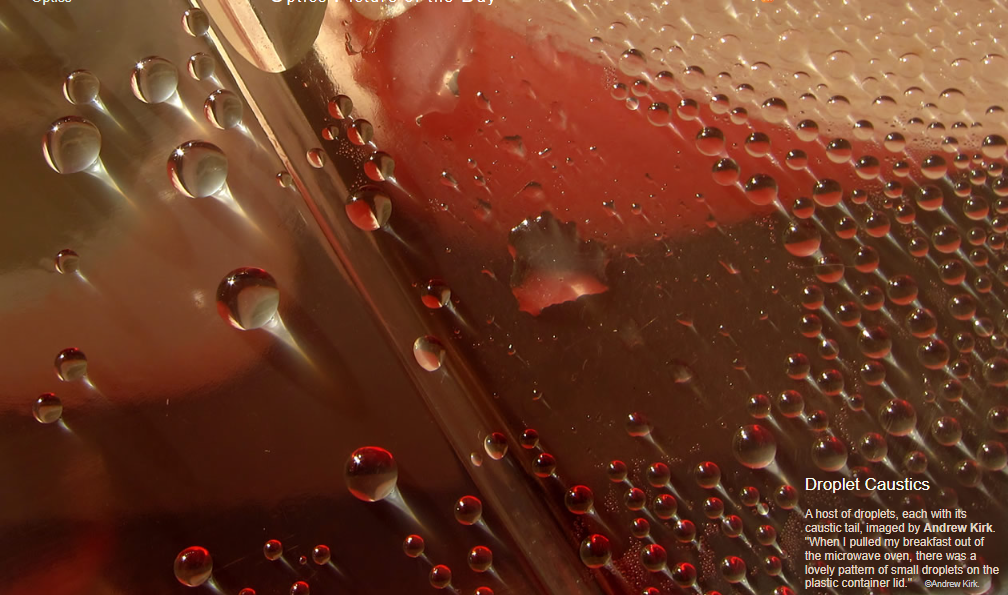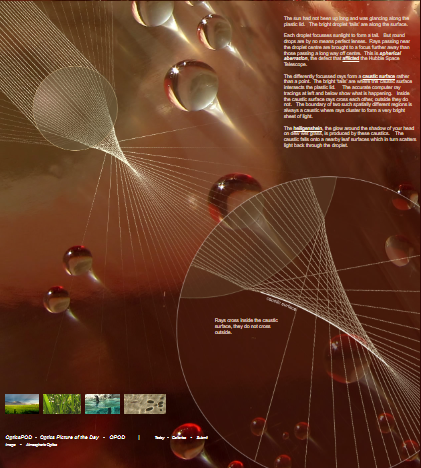OPOD - Breakfast Droplets
OPOD - Breakfast Droplets: Unveiling the Beauty of Droplet Caustics
Have you ever noticed the mesmerizing patterns created by droplets on a surface? In this article, we will delve into the captivating phenomenon of droplet caustics, specifically focusing on a fascinating observation made by Andrew Kirk while preparing his breakfast. Join us as we explore the science behind these enchanting patterns and uncover the secrets they hold.
The Breakfast Droplets Encounter
One fine morning, as the sun began to rise, Andrew Kirk found himself captivated by an unexpected sight. When he removed his breakfast from the microwave oven, he noticed an intricate pattern of small droplets adorning the plastic container lid. The sunlight, glancing along the lid's surface, revealed an array of bright droplet "tails" that seemed to dance in harmony. This serendipitous encounter served as the starting point for unraveling the captivating world of droplet caustics.
The Imperfect Lenses: Round Drops and Spherical Aberration
As each droplet basks in sunlight, it acts as a lens, focusing the incoming rays to form a tail. However, round drops are far from perfect lenses. The phenomenon of spherical aberration comes into play, causing rays passing near the droplet's center to focus further away compared to those passing farther from the center. Interestingly, this is the same optical defect that once plagued the Hubble Space Telescope.
The Birth of Caustic Surfaces
Due to the varying focus points of the rays, a caustic surface is formed instead of a single point of focus. The bright "tails" observed on the plastic lid are precisely where this caustic surface intersects with the surface. To gain a deeper understanding of this phenomenon, accurate computer ray tracings have been generated to visualize what is occurring. Inside the caustic surface, rays intersect with one another, while outside the surface, they do not. The boundary between these two spatially distinct regions always manifests as a caustic, where rays cluster together, creating a brilliant sheet of light.
Illuminating the Heiligenschein
The heiligenschein, a captivating glow that surrounds the shadow of your head on dew-wet grass, is a direct result of these caustics. When the caustic falls onto nearby leaf surfaces, it scatters light back through the droplet, producing this ethereal phenomenon. The intricate interplay between light and droplets gives rise to a mesmerizing spectacle that enchants all who witness it.
Embracing the Beauty of Droplet Caustics
The discovery of droplet caustics adds another layer of awe-inspiring beauty to the natural world. It showcases how even seemingly mundane occurrences, like droplets on a plastic lid, can hold profound secrets and reveal stunning optical phenomena. By observing and appreciating these intricate patterns, we gain a deeper understanding of the complex interplay between light and matter that shapes our perception of the world around us.
Conclusion
In this exploration of droplet caustics, we have ventured into the realm of captivating optical phenomena. From Andrew Kirk's chance encounter with breakfast droplets to the formation of caustic surfaces and their role in illuminating the heiligenschein, we have witnessed the extraordinary beauty that lies within seemingly ordinary occurrences. The intricate dance between light and droplets continues to amaze and inspire us, reminding us of the boundless wonders that await our curious gaze.

Droplet Caustics
A host of droplets, each with its caustic tail, imaged by Andrew Kirk. "When I pulled my breakfast out of the microwave oven, there was a lovely pattern of small droplets on the plastic container lid." ©Andrew Kirk.

The sun had not been up long and was glancing along the plastic lid. The bright droplet ‘tails’ are along the surface.
Each droplet focusses sunlight to form a tail. But round drops are by no means perfect lenses. Rays passing near the droplet centre are brought to a focus further away than those passing a long way off centre. This is spherical aberration, the defect that afflicted the Hubble Space Telescope.
The differently focussed rays form a caustic surface rather than a point. The bright ‘tails’ are where the caustic surface intersects the plastic lid. The accurate computer ray tracings at left and below show what is happening. Inside the caustic surface rays cross each other, outside they do not. The boundary of two such spatially different regions is always a caustic where rays cluster to form a very bright sheet of light.
The heiligenshein, the glow around the shadow of your head on dew wet grass, is produced by these caustics. The caustic falls onto a nearby leaf surfaces which in turn scatters light back through the droplet.
Rays cross inside the caustic surface, they do not cross outside.
Note: this article has been automatically converted from the old site and may not appear as intended. You can find the original article here.
Reference Atmospheric Optics
If you use any of the definitions, information, or data presented on Atmospheric Optics, please copy the link or reference below to properly credit us as the reference source. Thank you!
-
<a href="https://atoptics.co.uk/blog/opod-breakfast-droplets/">OPOD - Breakfast Droplets</a>
-
"OPOD - Breakfast Droplets". Atmospheric Optics. Accessed on December 22, 2024. https://atoptics.co.uk/blog/opod-breakfast-droplets/.
-
"OPOD - Breakfast Droplets". Atmospheric Optics, https://atoptics.co.uk/blog/opod-breakfast-droplets/. Accessed 22 December, 2024
-
OPOD - Breakfast Droplets. Atmospheric Optics. Retrieved from https://atoptics.co.uk/blog/opod-breakfast-droplets/.